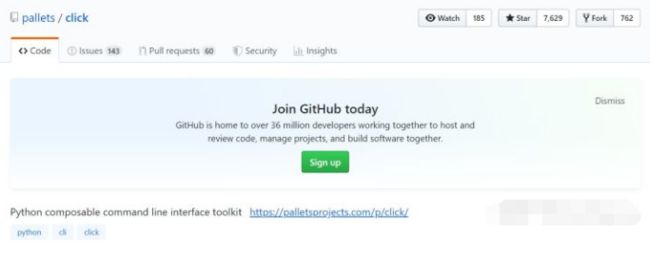在Python开发和测试过程中主要有两种模式可以选择:脚本模式、命令行模式。在代码的开发和调试过程中使用脚本模式还是很方便的,尤其接触pycharm、eclipse这类强大的IDE,或者配合vs code这种综合的文本编辑器。但是如果使用纯文本编辑器,或者是在做整个系统开发时,与其他模型进行接口调用时,命令行模式就显得非常重要了。目前有很多热门的命令行工具,本文会一一介绍一下,并且重点介绍一下最近发现的一款命令行神器Click。
前言
命令行模式在Python开发中并不陌生,简单的说就是python hello_world.py这种使用命令的模式运行Python程序。目前比较主流的命令行工具主要有以下几项,
- 内置的sys
- argparse
- tensorflow的Flags
当然,还有其他的,例如,Fire、Docopt,工具有很多,本文不在这里一一展开,概括性的讲解一下上述三款命令行工具,详细的阐述一下本文的重点Click,因为,相对而言这款工具实在太方便、太强大了。
Python学习交流群:835017344,这里是python学习者聚集地,有大牛答疑,有资源共享!有想学习python编程的,或是转行,或是大学生,还有工作中想提升自己能力的,正在学习的小伙伴欢迎加入学习。
sys
sys和os一样,是Python自带且非常常用的模块,该模块主要作用就是获取和Python解释器相关的一些信息,它的一个常见用途就是获取命令行参数,
import sys
def hello_world():
print(sys.argv[1], sys.argv[2])
hello_world()
# 输出
$ python test.py 1 2
>>> 1 2
sys通过argv来获取命令行参数,其中argv[0]获取的是脚本的名称,从argv[1]开始获取的是命令行传入的参数。
argparse
argparse是用的非常多的一种命令行工具,它支持选项命名,指定数据类型,添加帮助信息,设置默认参数,功能非常全面而强大,因此非常受欢迎,
import argparse
arg = argparse.ArgumentParser("This is a test!")
def main(arg):
print(arg.name)
print(arg.age)
if __name__ == '__main__':
arg.add_argument("--name", "-n", default="China", type=str, help="the name of your country.")
arg.add_argument("--age", "-a", default=25, type=int, help="your age.")
args = arg.parse_args()
main(args)
可以查看帮助,
# 输出
$ python test.py --help
usage: This is a test! [-h] [--name NAME] [--age AGE]
optional arguments:
-h, --help show this help message and exit
--name NAME, -n NAME the name of your country.
--age AGE, -a AGE your age.
可以输入对应的参数,
$ python test.py --name Chinese --age 26
Chinese
26
也可以使用简写在命令行传入参数,
$ python test.py -n Chinese -a 26
Chinese
26
FLAGS
做深度学习相关方向,尤其经常使用tensorflow的应该对这个命令行工具比较熟悉,FLAGS是tensorflow提供的一款命令行工具,和大多数命令行工具大同小异,
import tensorflow as tf
FLAGS = tf.flags.FLAGS
tf.flags.DEFINE_string("train_path", '/voc2012/JPEG', "training file path")
tf.flags.DEFINE_integer("batch_size", 64, "training batch size")
tf.flags.DEFINE_float("lr", 0.01, "learning rate")
def main(_):
print(FLAGS.train_path)
print(FLAGS.batch_size)
print(FLAGS.lr)
if __name__ == '__main__':
tf.app.run()
查看帮助,
$ python test.py --help
# 输出
USAGE: test.py [flags]
flags:
test.py:
--batch_size: training batch size
(default: '64')
(an integer)
--lr: learning rate
(default: '0.01')
(a number)
--train_path: training file path
(default: '/voc2012/JPEG')
Try --helpfull to get a list of all flags.
命令行传入参数,
$ python test.py --train_path /home/li/images --batch_size 128 --lr 0.001
# 输出
/home/li/images
128
0.001
Click
下面要介绍的就是本文的主角Click,这款工具是用flask的开发团队pallets进行开发,目前在github已经7.6k+star,受欢迎程度可见一斑,
Click的开发初衷就是使用最少的代码,以一种可组合的方式创建漂亮的命令行接口。它的目的是使编写命令行工具的过程快速而有趣,同时防止由于无法实现预期的CLI API而导致的任何问题。
Click主要有以下3个亮点:
- 命令的任意嵌套
- 自动帮助页面生成
- 支持在运行时延迟加载子命令
安装
$ pip install click
Click支持Python 3.4和更新版本、Python 2.7和PyPy。
首先先来一个例子,
import click
@click.command()
@click.option("--name", default="li", help="your name")
@click.option("--age", default=26, help="your age")
def hello_world(name, age):
click.echo(name)
print(age)
hello_world()
命令行调用,
$ python test.py --name ll --age 27
# 输出
ll
27
可以看出,上述主要用了click的3个方法,分别是,
- command
- option
- echo
这3个方法在Click工具中至关重要,除此之外还有其他的方法,它们的功能分别是,
方法功能
- command:用于装饰一个函数,使得该函数作为命令行的接口,例如上述装饰hello_world
- option:用于装饰一个函数,主要功能是为命令行添加选项
- echo:用于输出结果,由于print函数在2.x和3.x之间存在不同之处,为了更好的兼容性,因此提供了echo输出方法
- Choice:输入为一个列表,列表中为选项可选择的值
把上述程序的帮助信息输出,
$ python test.py --help
Usage: test.py [OPTIONS]
Options:
--name TEXT your name
--age INTEGER your age
--help Show this message and exit.
在示例程序中,对于option只使用了default、help两个属性,除此之外option还有其他的属性选项,它们的功能如下,
属性描述
- default:给命令行选项添加默认值
- help:给命令行选项添加帮助信息
- type:指定参数的数据类型,例如int、str、float
- required:是否为必填选项,True为必填,False为非必填
- prompt:在命令行提示用户输入对应选项的信息
- nargs:指定命令行选项接收参数的个数,如果超过则会报错
除此之外,Click还提供了group方法,该方法可以添加多个子命令,
import click
@click.group()
def first():
print("hello world")
@click.command()
@click.option("--name", help="the name")
def second(name):
print("this is second: {}".format(name))
@click.command()
def third():
print("this is third")
first.add_command(second)
first.add_command(third)
first()
调用子命令second,
$ python test.py second --name hh
# 输出
hello world
this is second: hh
